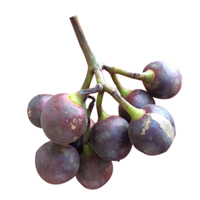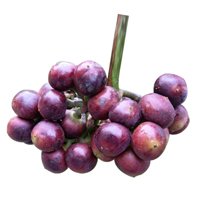 Full List of Fruits
Full List of Fruits  Amazon-Tree Grape
Amazon-Tree GrapeAmazon-Tree Grape
![]() Introduction of Amazon-tree grape
Introduction of Amazon-tree grape
Scientific name - Vitis vinifera
Amazon Tree Grape has its origin in South Africa. Though it is grown wild, the trees are also cultivated in home gardens. It comes with different names. When it comes to the taste of this fruit, it is really sweet and is enjoyed by the people. They nearly give you the taste of grapes.
Amazon Tree Grape (Cissus Amazonica) is a tropical vine native to the Amazon rainforest. It is part of the Vitaceae family and is sometimes referred to as Amazon Creeper, Amazon Ivy, or Amazon Vine. This fast-growing vine is known for its dark green leaves and its white, green, or yellow flowers. The fruits of the vine look like small grapes and have a sweet, sour taste.
Amazon Tree Grape is a great choice for those looking to add a tropical touch to their landscape. It can be grown in hanging baskets, on trellises or fences, or in containers. It does best in warm and humid climates and does not tolerate cold temperatures.
![]() Nutritional Value of Amazon Tree Grape
Nutritional Value of Amazon Tree Grape
This tree is medium-sized and the fruits are edible. It can be consumed fresh. The utility of the fruits can be seen when it is transformed into jam. You can also get wine from Amazon grapes. The Amazon Tree Grape is a good source of essential vitamins and minerals. It contains a high amount of vitamin A, vitamin C, and iron. It also contains other minerals such as magnesium, phosphorus, and zinc.
Though it is sweet and is edible, the fruit are somewhat fragile. Seeds are not found in Amazon tree grape. This fruit will not withstand frost. It is locally cultivated for years together in Western Brazil, Ecuador, and Peru.The Amazon Tree Grape is a great source of omega-3 fatty acids, which are known to help reduce inflammation and improve heart health. It is also rich in anthocyanins, which can help to reduce the risk of cancer.In addition to its nutritional benefits, the Amazon Tree Grape is also known to have medicinal properties. Studies have shown that it can help to reduce inflammation and improve brain function. It can also help to boost the immune system and reduce the risk of certain diseases.
| Principle | Nutrient Value | Percentage of RDA |
|---|---|---|
| Energy | 69 Kcal | 3.5% |
| Carbohydrates | 18 g | 14% |
| Protein | 0.72 g | 1% |
| Total Fat | 0.16 g | 0.5% |
| Cholesterol | 0 mg | 0% |
| Dietary Fiber | 0.9 g | 2% |
| Vitamins | ||
| Folates | 2 µg | 0.5% |
| Niacin | 2 µg | 1% |
| Pantothenic acid | 0.050 mg | 1% |
| Pyridoxine | 0.086 mg | 7.5% |
| Riboflavin | 0.070 mg | 5% |
| Thiamin | 0.069 mg | 6% |
| Vitamin A | 66 IU | 3% |
| Vitamin C | 10.8 mg | 18% | Vitamin E | 0.19 mg | 1% |
| Vitamin K | 14.6 µg | 12% |
| Electrolytes | ||
| Sodium | 0 mg | 1 mg |
| Potassium | 191 mg | 4% |
| Minerals | ||
| Calcium | 10 mg | 1% |
| Copper | 0.127 mg | 14% |
| Iron | 0.36 mg | 4.5% |
| Magnesium | 7 mg | 2% |
| Manganese | 0.071 mg | 3% |
| Zinc | 0.07 mg | 0.5% |
| Phyto-nutrients | ||
| Carotene-a | 1 µg | -- |
| Carotene-ß | 39 µg | --- |
| Crypto-xanthin-ß | 0 µg | -- |
| Lutein-zeaxanthin | 72 µg | -- |
![]() Health Benefits of Amazon-tree grape
Health Benefits of Amazon-tree grape
Preventing Heart disease.
The beast way to lose belly fat
Manage diabetes.
weight loss.
Amazon-Tree Grape, also known as Passiflora amazonica, is a species of flowering vine belonging to the passionflower family, Passifloraceae. It is native to the Amazon rainforest in Peru, Brazil, and Colombia. The plant is known for its showy, purple flowers and edible fruit, which has a sweet, tart flavor. The Amazon-Tree Grape is a fast-growing, woody climber with a woody stem and green, leathery leaves that can reach up to three feet in length. The vine is typically twined around the trunks of trees and other supports, reaching heights of up to 30 feet. Its beautiful flowers are purple and white, typically containing five petals and an array of filaments and anthers. The flowers are often fragrant, and the vine is pollinated by hummingbirds and butterflies.
The Amazon-Tree Grape produces an edible fruit that is round, yellow, and about the size of a small plum. The fruit has a sweet tart flavor and is commonly used in jams, jellies, and other preserves. The fruit is also eaten fresh, and the seeds are used to make a tea. The Amazon-Tree Grape is a hardy, versatile plant that can thrive in many different climates and soils. It prefers moist, well-drained soils and does best in full sun to partial shade. The plant is drought tolerant and can withstand occasional flooding. It can tolerate temperatures from -4 to 104 degrees Fahrenheit.
The Amazon-Tree Grape (Vitis Amazonica) is a species of perennial vine native to the tropical rainforest of Central and South America. The Amazon-Tree Grape has been used by indigenous cultures in South and Central America for centuries. It is believed to have medicinal properties, and is often brewed into a tea to help with digestive issues, or as a treatment for respiratory ailments. It is also believed to have anti-inflammatory and antioxidant properties.The Amazon-Tree Grape is not only a medicinal plant, but also an important source of food.
The leaves, stems, and fruits are edible and are often used in stews and soups. The fruits can also be eaten raw, or they can be dried and made into a powder that can be used as a seasoning or to make wine.The Amazon-Tree Grape can be grown in the home garden, or in a pot on a patio or balcony. They prefer full sun, but will tolerate some shade.The vines provide habitat for birds and other wildlife, and the flowers attract pollinators such as hummingbirds and bees.The fruits are also an important food source for many animals, including monkeys, sloths, and toucans. The Amazon-Tree Grape is an important part of the tropical rainforest, both ecologically and culturally. It provides food and medicine, as well as an important habitat for numerous species of wildlife.



















